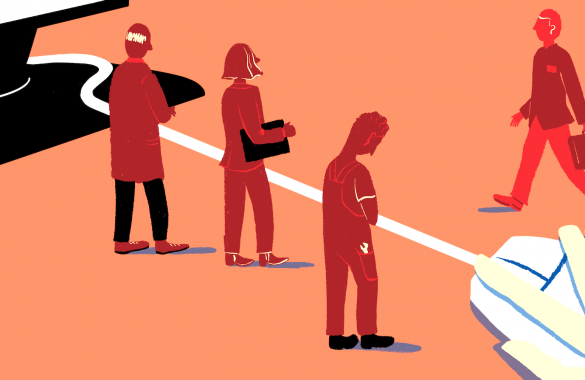Social media companies are keenly focused on ridding their platforms of hateful speech and harassment. But content moderation can only capture a small fraction of it, and automatic filters can risk censoring ordinary users. Another approach is to counter these messages with opposing points. IPL researchers tested various kinds of counterspeech on Twitter, and they found that messages invoking empathy worked better than any other—they led authors of hate speech to discontinue their posts and even delete old ones.
Plenty of media coverage and policymaking in the West has focused on African migration to Europe, fueling a widespread perception that Europe is the destination of choice for Africans seeking economic opportunity. But the reality differs widely from this narrative, according to an IPL analysis of data collected at transit hubs across West and Central Africa. Only a small share of migrants surveyed want to reach Europe, and their motivations are complex.
Health clinics that serve unauthorized immigrants often see their patients avoid seeking care when immigration enforcement is active nearby. IPL researchers looked for this trend in the San Francisco Bay Area and found no sign that immigrants there reduce their use of health services at times when they might have greater reason to fear deportation. It could be that the city's inclusive health system and welcoming climate act as a buffer against these otherwise threatening events.
Immigration Policy Lab researchers at ETH Zurich leveraged big data from recruitment platforms and machine learning to study discrimination in hiring. After analyzing anonymized data on recruiter decision-making and which candidates were contacted, they showed that immigrant job seekers were 6.5 percent less likely to be contacted as compared with Swiss job seekers with otherwise identical characteristics.
Whether you do academic research or nonprofit work, you've probably experienced the challenges that come with conducting surveys. It's difficult to keep in touch with study participants or clients over time, and surveys can be expensive and time-consuming. IPL found a solution in WhatsApp, which allows respondents to fill out a survey through automated messages on their mobile phones.
Most of the world's refugees live in developing countries. Those countries are largely overlooked in the research on dynamics between refugees and the communities hosting them. IPL conducted a survey in Jordan, one of the top destinations for Syrian refugees. It found that most Jordanians have strong humanitarian concern for the refugees, even though they believe the refugee crisis has strained their economy and social services.
When refugees are resettled in the United States, they're assigned to live in a specific location. But many refugees move to a different state within their first several years in the country. What are they looking for? According to a new dataset on nearly 450,000 refugees, they mostly seek two things that will help them rebuild their lives: better job markets and others from their home country.
Two immigrants apply for citizenship, and one is narrowly approved while the other just barely misses out. How does this chance decision affect their lives more than a decade later? According to IPL research, the immigrant who became a citizen is likely to earn more money than the one who remained a permanent resident. And for immigrants who work in lower-skill jobs or who face discrimination in the job market, citizenship delivers an even bigger boost to their earnings over the long term.
The United States has seen a rise in political rhetoric and federal policy based on the “welfare magnet” idea that immigrants pose a fiscal challenge to social safety net programs, especially publicly funded health coverage. But is there any evidence of this? IPL studied the state-by-state expansion of Medicaid to include recently arrived immigrants, and the results suggest that immigrants don’t strategically move to other states to claim these benefits.











